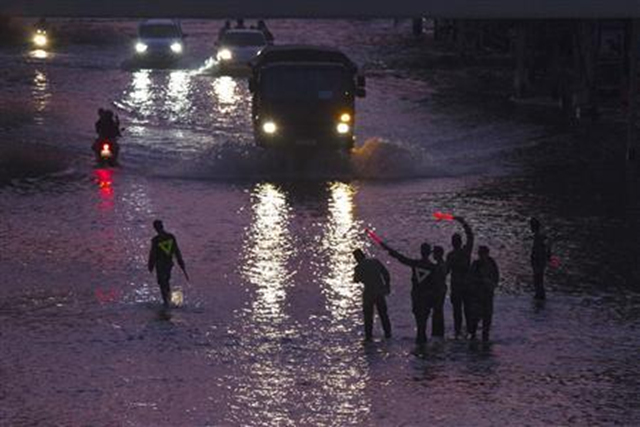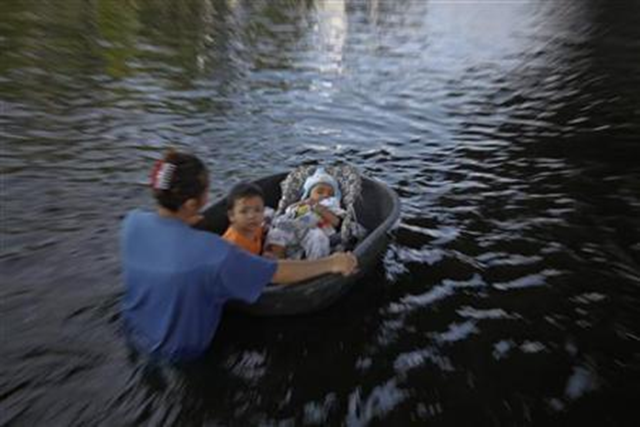Bangkok faces weeks of flood woes – ‘Slow, suffocating death of the Bangkok business area’
From David Challenger, with CNN’s Liz Neisloss and Kocha Olarn contributing
10 November 2011 (CNN) – As Thailand continues to battle its worst floods in 50 years, a political analyst involved in the relief effort predicted that streets in the capital would remain flooded for at least two weeks. “The best-case scenario, two weeks, or one month at its worst case,” Sean Boonprakong told CNN. In all, 255 pumps were being used to drain the water, he said, crediting their work for sparing much of inner Bangkok from the floodwaters. Though some tourists were trickling in, city life was far from business as usual, he said. “I think that most people (who live) here — Thai and foreign alike — are anxious,” he said. Indeed, Bangkok residents have plenty to be anxious about. They are dealing with massive piles of garbage stacking up around the flood-stricken city, prompting worries over tainted water, disease, and sanitation. In a nation that, according to the Bangkok Metropolitan Administration, produces 8,000 tons of garbage a day during normal times, Bangkok residents are dealing with massive piles of trash stacking up around the flood-stricken city. “There might be over 3 million tons of garbage left over in Bangkok after the floods,” Deputy Director General Warasart Apaipong of the Pollution Control Department told CNN. “Five hundred thousand cars might need to be junked, as they would produce toxin wastes from their batteries and engine oil.” Concerns about disease spreading are also growing. The country’s Ministry of Public Heath has distributed 20,700 test kits for leptospirosis, a severe bacterial infection that can affect areas where water has been stagnant for more than three weeks. The ministry reported that up until November 7, more than 1.3 million people had become sick in provinces affected by the floods, of which athlete’s foot accounted for almost 70% of cases. Water quality in some areas is also being affected, according to Bangkok resident Anisha Prachaseri, while other newer dangers are presenting themselves. “People have been buying many more bottles of water than normal as there’s a problem with tap water, which has been contaminated with floodwaters after it leaked into the pipes,” she said. Anisha reported that many people are still not able to get out of their homes without a boat, with water levels in many places still two meters above normal. Countless people are also refusing to evacuate their homes, despite government orders to do so. “There’s a great deal of fear that people will electrocuted in the flooded areas if they remain in their homes,” she said. “Disease is also a real concern right now.” Meanwhile, Thailand’s prime minister has laid out a three-point plan to get the country back on its feet. Immediate aid will be issued to people whose homes and businesses have been destroyed by the floods, which have claimed more than 500 lives since July, Yingluck Shinawatra announced Tuesday. “This disaster is the biggest that we have ever met. We’re trying to cope with situation and help as much as we can,” she said. “We can’t stop all flooding but we will try to reduce the impact.” […] The prime minister’s promises came as murky waters continued to move towards Bangkok’s city center. “The situation is quite serious. The water is making ground slowly but surely towards the heart of Bangkok,” flood relief co-ordinator Rungsun Munkong told CNN. Relief workers, distributing aid to evacuation centers in central Bangkok, said they were struggling to reach residents determined to wait out the crisis in tower blocks. “I think it will be difficult down the road to get help to these people,” Rungsun said. “People need clean water, that’s the first important thing. Cooked ready-to-eat food is also quite important, baby milk and so on.” A Thailand Disaster and Mitigation Department report, issued Sunday and reported by the state-run MCOT news agency, estimated about 3.1 million people have been affected and 4 million acres of farmland have been damaged. Moreover, the department said two people are believed missing and about 75 highways have closed. […] Floods are an annual occurrence in the country but have been particularly acute this year, and some residents and analysts have criticized the government’s response. “Now the government is sending a mixed signal that the situation is fine, but the truth is it the situation far from over,” political analyst Supong Limtanakul told CNN. “It is a slow suffocating death of (the) Bangkok business area.” The city’s main airport and two large industrial sites are also at risk, Supong said. Supong said the government did not have enough resources to deal with floodwaters, noting that officials had recently asked the private sector for water pumps to help drain water out of Bangkok. M.R. Sukhumbhand Paribatra, Bangkok’s governor, told MCOT that it may take up to two weeks to drain water out of Bangkok’s main roads, and months to drain water from smaller roads.
Bangkok Faces Weeks Of Flood Woes 
By Alan Raybould and Prapan Chankaew, with additional reporting by Martin Petty, Aukkarapon Niyomyat, Sinthana Kosolpradit, Panarat Thepgumpanat, Orathai Sriring, and Ploy Ten Kate; Editing by Jason Szep and Robert Birsel
9 November 2011 BANGKOK (Reuters) – Prime Minister Yingluck Shinawatra pledged more than $4 billion on Wednesday to help Thailand recover from the worst floods in half a century, as workers slowed the flow of water threatening the commercial heart of the capital, Bangkok. Evacuation orders have spread to a third of Bangkok’s districts, mostly in the north of the densely populated city of 12 million people, since late October, as floodwater strewn with trash slowly seeps in from northern and northeastern provinces. Yingluck, a political novice elected this year, said about 120 billion baht($3.9 billion) had been set aside for a flood recovery effort, a figure that rises to 130 billion baht ($4.2 billion) when local government funds are added. On the streets of Bangkok, few see an end to the slow-moving disaster that began after tropical storm Nock-ten battered Southeast Asia in late July. Since then, at least 529 people have been killed, many electrocuted or drowned, in floods that have affected 63 of Thailand’s 77 provinces. Some hard-hit regions have started to recover since the end of the August-to-October monsoon season, with only 24 provinces now classified as flooded. But for low-lying Bangkok, the disaster is far from over, as the authorities struggle to keep inner-city neighborhoods and business districts dry. “I’m concerned about more water reaching Bangkok and I just want to know when it will recede. It’s rising and it should recede but when will that be?” said Bangkok resident, Nee Jiranantawat, 53. Others said they feared they may run low on food and other supplies, especially in homes flooded in waist-high water. Nikom Teo-au, a 56-year-old garage owner, said he was facing difficulty delivering food to his family at his home on a street under up to 1.5 meters (4.9 ft) of water in Bangkok’s Din Daeng neighborhood, just 7 km (4.3 miles) from the main Silom business district where buildings are ringed with sand bags. […] Workers and soldiers are trying to hold the line at the city’s Bang Sue canal, pushing water into the Chao Phraya river and stopping it from overflowing to the south. Reuters reporters in the area said they had mostly achieved this so far. Even so, with each week, the water has slowly drawn closer to the business district and the Ratchaprasong intersection, whose swanky shopping malls and five-star hotels were closed for weeks by political protests in April-May last year. The major north-south Ratchadaphisek and Viphavadi-Rangsit roads were flooded in the vicinity of the Bang Sue canal. A Reuters reporter said the area was under 60 cm (2 ft) of dark, foul-smelling water in places, with trash on the surface. Chatuchak market, whose 11,000 stalls are a draw for tourists and residents alike, opened last weekend but was now submerged, with vendors’ carts and tables washed away and stray dogs taking refuge on the rooftops, the reporter said. […] The Chao Phraya river snaking through Bangkok has another phase of high tides from Thursday to Monday and riverside communities are braced for floods, especially on the relatively dry east bank, although a navy official said the river should not reach the record high levels seen at the end of October. […]
Thai PM pledges flood relief as fight for Bangkok goes on 
By ALISA TANG, Associated Press
10 November 2011 BANGKOK (AP) – Thailand offered more help Thursday to businesses affected by widespread flooding, as water spread deeper into Bangkok and threatened to cut off a major highway. The flooding since late July has killed 533 people, caused billions of dollars in damage, and inundated hundreds of factories north of the capital. Water draining from central and northern provinces to the sea has surrounded Bangkok, threatening chaos in the crowded city of more than 9 million people. The floodwaters are also trickling onto the main route south from the city, Rama II Road. If the water gets deeper, it will cut off the last dry highway to Thailand’s south. An irrigation department official said floodwaters in Bangkok’s outskirts are likely to fall but must still pass through as-yet unaffected parts of the capital to reach the sea. While some water will drain out through rivers, some will have to flow through city streets because there is such an enormous amount, said Boonsanong Suchatpong, spokesman for the Royal Irrigation Department. The industrial closures have had effects well beyond Thailand, since the factories supply key components for several industries, particularly automobiles and computers. Thailand’s Board of Investment already has taken some steps to help flooded companies, such as allowing tax write-offs for damaged raw materials and easing rules on bringing in foreign nationals to help with recovery. New measures announced Thursday include allowing companies to temporarily outsource production to maintain customer deliveries and extending import tax exemptions on replacements for damaged machinery. Japanese companies including Honda and Toyota have been especially hard hit. Some have complained they were not given timely and accurate information that would have allowed them to prepare for the floods. […]
